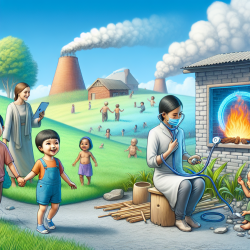Introduction
In the pursuit of enhancing children's health outcomes, leveraging data-driven insights is paramount. As practitioners in the field of speech language pathology, it is crucial to integrate findings from diverse research areas to inform our practices. One such area is environmental health, particularly the impact of household air pollution on vulnerable populations. A recent study titled Comparison of Liquefied Petroleum Gas Cookstoves and Wood Cooking Fires on PM2.5 Trends in Brick Workers’ Homes in Nepal offers valuable insights that can be applied to our work.
Understanding the Research
The study conducted by Johnston et al. (2020) compared PM2.5 levels in homes using liquefied petroleum gas (LPG) cookstoves versus traditional wood fires. PM2.5, or fine particulate matter, is a significant air pollutant linked to respiratory issues. The research found that PM2.5 levels were significantly lower in homes using LPG cookstoves compared to those using wood fires. This is a critical finding, as high PM2.5 levels are associated with adverse health effects, particularly in children, including respiratory illnesses and impaired cognitive development.
Implications for Practitioners
While the study focused on brick workers' homes in Nepal, the implications extend to broader contexts, including online therapy services for children. Here are some ways practitioners can leverage these findings:
- Environmental Awareness: Educate families about the impact of household air pollution on children's health and development. Encourage the adoption of cleaner cooking methods where feasible.
- Integrating Environmental Health: Consider environmental factors when assessing children's health and developmental challenges. This holistic approach can lead to more comprehensive care plans.
- Advocacy and Policy Influence: Use research findings to advocate for policies that promote cleaner household environments, particularly in underserved communities.
Encouraging Further Research
The study underscores the need for continued research into the environmental determinants of health. Practitioners can contribute by:
- Collaborative Research: Partner with environmental health researchers to explore the intersection of air quality and child development.
- Data Collection: Implement data collection methods in practice to gather evidence on environmental impacts on therapy outcomes.
- Innovation in Practice: Develop and test interventions that mitigate the effects of environmental pollutants on children's health.
Conclusion
By integrating findings from environmental health research, practitioners can enhance their impact on children's health outcomes. The study on PM2.5 levels in Nepal provides a compelling case for the adoption of cleaner cooking technologies and highlights the broader implications for child health. Embracing a data-driven approach and fostering interdisciplinary collaborations will pave the way for more effective and comprehensive care strategies.
To read the original research paper, please follow this link: Comparison of Liquefied Petroleum Gas Cookstoves and Wood Cooking Fires on PM2.5 Trends in Brick Workers’ Homes in Nepal.










